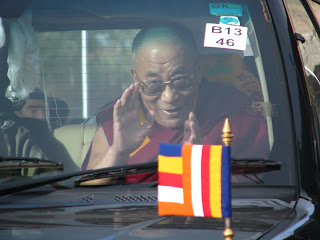
Monday, October 19, 2009
Sunday, October 18, 2009
Phuktal Gompa, Zanskar





The origins of Phuktal Gompa are said to be traced back to a monk who attained enlightenment in a cave 2000 years ago. It is from this cave that the Phuktal monastery arose in its present day form. Inhabited by over 70 monks and a three days walk from the main town of Zanskar one feels a million miles away from the 21st century.
The Dalai Lama's Teachings in Zanskar



Zanskar is one of the remotest Himalayan regions of Northern India and so consequently travel to and from there is one of the most difficult. That didn't stop thousands of Zanskaris and Ladakhis coming by road and many days walk in the mountains to arrive in the capital, Padum, for the three day teachings of the Dalai Lama.
Thousands of people with offerings and blessings waited to greet him as he arrived by helicopter. And later withstood heat, wind and dust to hear his lectures on Buddhist philosophies.
And his Holiness, always with his charming smile and humble appearance, satisfied many thousands who feared that this would be their last glimpse of him after a lifetime of reverence.
The Brokpa Community of Ladakh, India

Nestled on a small patch of fertile land and situated at the confluence of the Shayok and Indus river is the village of Dha Hanu, an Indo Aryan community of people thought to be descendants of Alexander the Great. They are visibly different from the mongoloid features of the Ladakhis who are primarily of Tibetan descent, and although Tibetan Buddhism has colored some aspects of their culture, they remain closer to their shamanistic roots.
Only 19 kms from the border with Pakistan, they are believed to be migrants from the Gilgit area where one can still see a similarity of culture and language. It is no surprise that there is a heavy military population in this sensitive border area.
One of the most striking features of these people are the fresh bouquets of flowers they wear atop their heads from where long pieces of braided hair hang. The traditional dress is slowly being discarded by the youth for a more modern and manageable attire, but one can still see the elders keeping to their traditions daily and at festival times.
Somehow the Brokpa community have managed to maintain the purity of their bloodline through the ages but being sandwiched between the giant religions of Buddhism and Islam and numbering only 2000 peoples in 5 villages, it is hard to imagine what their future will be.
Subscribe to:
Comments (Atom)















